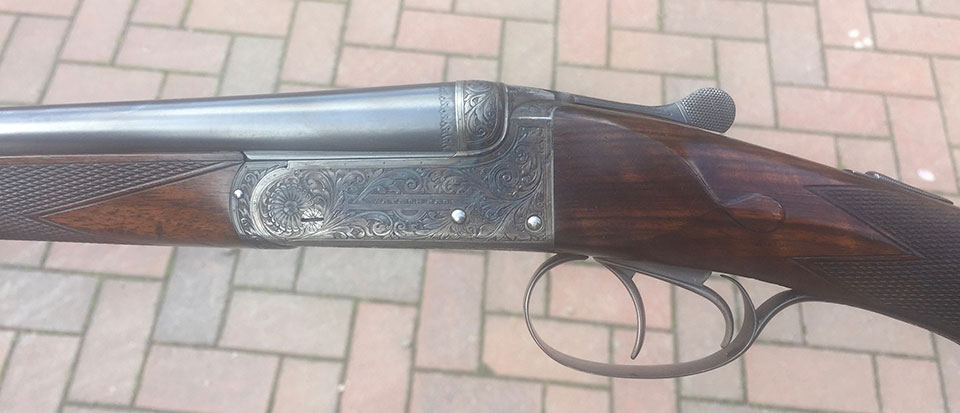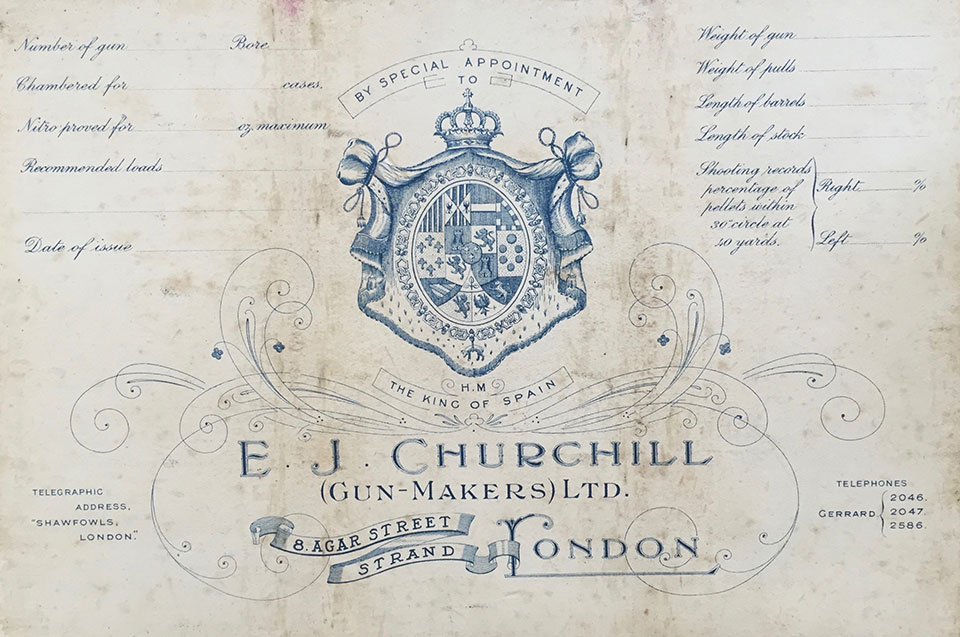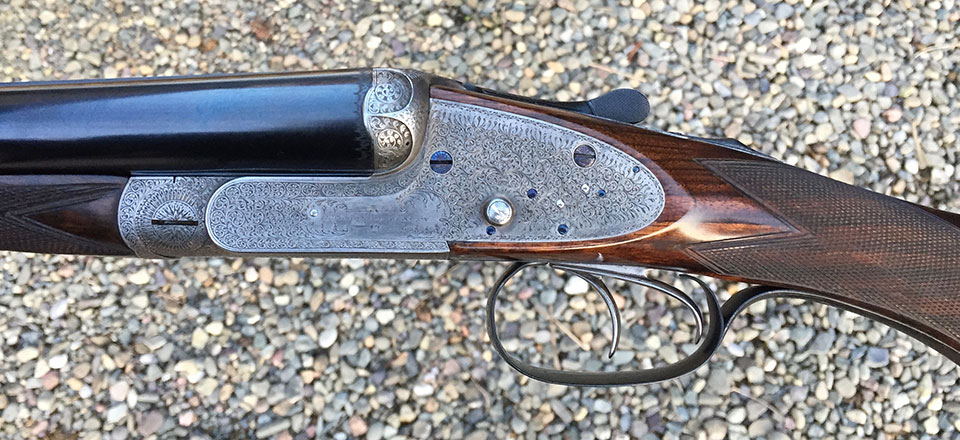Although much has been written about bores little need be said here, except to ask for what purpose is the gun intended, the age, and the handling abilities of the intending user ?
For a boy or girl, or for a lady beginning to shoot, a 410, 28, 20 or 16 bore is advocated, according to age, strength and gun-handling ability. Boys of course will, or should, as manhood comes into possession, take to the man’s gun, which is a 12 bore with weight of about 6 1/2 lbs, this is a useful weight gun for the average man for general game-shooting purposes, with present-day standard load cartridges.
Ladies, and of course the girls, who by beginning with a good teacher will develop into good lady shots, may, if a light 12 bore is desired, acquire a “Twentieth Century” 12 bore, chambered for 2-inch cases.
The 410 seems to have received its share of comment in sporting circles. The 3-inch chambered 410, with its latest load of 3/4 oz. shot, can hardly be termed a toy, and the 410 in general is indeed a useful gun for the garden or around a house or buildings where the larger bores might prove to be a nuisance ; a gun of this calibre, however, should give place to larger bores in game shooting, especially at tall pheasants.
Small bores will kill clean at reasonable shooting ranges, provided they have their respective standard loads, are properly bored, and are held straight. I have seen a 20 bore in the hands of a lady hold its own in a field of very useful guns at driven pheasants, and incidentally rabbits ; the pheasants were killed very clean and the rabbits were simply rolled over as dead as mutton.
A lady pupil of mine using a 20 bore killed 65 duck to her own gun in 2 1/2 hours. Yes, small bores will kill but they need a good shot behind them. One needs to be a good shot to do well with small bores because the pattern is smaller, and is more likely to be a “ kill ” or “ miss ”. Game is not so likely to be just dragged down or wounded with the edge of the pattern.
Whatever the bore of the gun or the length of the barrels, it is essential that the weapon fits the user, and that the user possesses the great asset - confidence! After all the battles of the bores, the 12 bore would, in the hands of one who can handle a 12 bore, prove the most reliable.
The desire in the present age seems to be for light, and even lighter, guns. During the last few years much controversy has been going on with regard to barrel-lengths. Much has been claimed for the 25 inch ; it has indeed boomed. But really short barrels are nothing new.
To give the 25 inch its due, it is ideal, built with a full pistol grip, for the one-armed shot who must shoot a gun like a pistol. Also it will usually prove more suitable for a short, thick-set person than for one of tall or medium build, but taking the 25 inch all round, it is not holding its own against longer barrels, and to split the difference between long and short, 27” 28” and 29 inch are becoming favoured.
It is sometimes considered unnecessary for barrel-length beyond 28 inches, but really there are cases where 29- or 30-inch barrels would be an advantage.
It seems rather strange that the height, reach and build of the shooter is not taken more into consideration when deciding on barrel-length. For a short person, say 27 inch ; for one up to 5 feet 10 inches or 6 feet in height, 28 or 29 inch ; whilst for one 6 feet or over, 29 or 30 inches, more especially if the said user be fairly active.It is sometimes asked—why carry extra inches of barrel if the short barrel will answer the purpose just as well? The answer is that the longer barrel steadies one, and that the shooting is more likely to be consistent ; this will apply with even 26” or 27” against 25 inch.
During the last decade, and since this boom of short barrels has been going on, and after a wide experience with them, both on the shooting ground and in the field, I am forced to the conclusion that 25-inch barrels are not the remedy for bad shooting. One well-known and reliable firm of gunmakers, who for a time were building and advertising 25 inch, have discontinued to do so, and instead are offering 27 and 28 inch. The finest gun-makers in the world have given them a trial ; if customers require them they will build, but do not recommend them. This speaks for itself. Many good shots after trying them have given them up and gone back to their old barrel-lengths.
Some in fact would have given anything to have got back their own guns given in part payment for the short barrel. Whatever may be claimed for 25 inch, the fact remains and is admitted, even by users of them, that the finest game-shots still use longer barrels. For real facts one must look to the shooting field, and it will be found that the longest runs of kills are made with the longer barrels, not necessarily 30 inch ; also it may be noticed that where birds are brought down by users of short barrels, the kills are not as clean as with longer barrels ; this at least has been my experience. It might be interesting to ask the keepers their opinion on this matter.
It has sometimes been claimed for short barrels that they will hold their own and even beat long barrels at long distances. That 25 inch can be bored to shoot good patterns there is no disputing, but that 25 inch will beat, say, 28 inch (providing the same amount of choke be in both guns), is wrong and misleading.
Brief life seems to be the portion of barrel-lengths of 25 inches. This is proved by the number of sportsmen who after trying them have gone back to longer barrels.
It will be asked, “ Why is this ? » It handles well. Yes, although it handles well it is far too whippy, erratic, and jumpy ; quickly on the bird perhaps, but quickly off again before one can shoot even with the first aim. It is not easier to shoot with than longer barrels any more than a pistol is easier to shoot with than a rifle. They are often built too light in proportion to their bore—for instance, models as light as 5 lb. weight even in a 12 bore. Now, although these said models are proved for 1 1/8 oz. shot, no standard load or even 1-oz. shot with an effective powder propellant can be used with any degree of comfort except by the most robust, whose desire would hardly be for such a light weapon, and considering the muzzle blast and also the recoil is far more excessive with the short barrels the recommendation of such light guns seems inevitably a mistake.
Humanely speaking it seems rather cruel to use such weapons on game because the users of such light 12 bores are not usually the strongest, and it will be admitted that a reduced charge is used to save recoil, thereby only pricking and wounding a number of birds shot at. This is only, of course, referring to over reduced charges which the writer knows has been used in these guns to save recoil ; the users themselves thinking that they have missed and often wondered why, not having the slightest idea that they have been hitting but only wounding their game.
Good penetration is necessary to kill cleanly at reasonable shooting distances and this cannot be obtained with reduced barrel-length, reduced weight of metal, and reduced powder and shot-charges, all thrown in together ; you cannot eat your cake and still have it. If it were absolutely necessary to shoot with a seriously reduced cartridge load it would be an advantage to rather increase barrel-length and weight. I have known cases where weight added to 25-inch barrels proved to be an advantage.
Substance is necessary somewhere. In a nutshell, greater penetration would be obtained with a reduced load from a 28-inch-barrel gun of medium weight, than from a lightweight gun of 25-inch barrel-length. Also a 20 bore of say 5 lb. weight and barrel-length of 28 inches would be more likely to kill farther and cleaner with a proper 20-bore charge, than would a 25-inch barrel, 12 bore, of the same weight and with the same loading.
Many users of 25-inch guns will realise how much better they shot with the try-gun when fitted, compared to the shooting with their new guns.
Many users of 25-inch guns will realise how much better they shot with the try-gun when fitted, compared to the shooting with their new guns ; this is easily explained by the fact that the weight of the try-gun steadied them.
It was claimed a few years ago by one advocate that cast-off was not required with 25-inch barrels. Experience, however, has proved otherwise and it will usually be found in gunfitting that still more is required, and where considerable cast-off is required it will generally be found that a more distorted stock will be needed to put one straight, than with barrel-length of say 28 inches.
No enthusiastic sportsman wishes to give up whilst a gun can be held, and the writer is the last person in the world to suggest it, but when Anno Domini or body infirmities control, and one is compelled to change to lighter and handier weapons than of yore, and needs a gun of lighter weight than 6 lb., then a 16 or 20 bore in 28-inch barrels will be found more suitable than the very light 12 bore mentioned, and will kill clean with their respective standard loadings at any reasonable shooting distances and furthermore, can be used with comfort.
It must not be supposed that longer barrelled guns than 25 inches are necessarily muzzle heavy and badly balanced ; they need not be, and the 3 inches or so at the muzzle end of the gun really adds very little weight.
The finest balanced guns I have handled, and these may be claimed to be some few thousands, have been 27-, 28- and 29-inch barrels, and I sincerely believe that the most popular barrel-lengths of the future for game shooting will be 27, 28, and 29 inches.
Should a 16 bore be favoured this can be built in 6 lb. weight and chambered for 2 3/4-inch cases, shooting a 1-oz. charge without undue recoil, and good killing patterns can be obtained at 40 yards.
Where one is wavering between bores, feeling that something handier than a 12 is required and yet desiring a really effective weapon, this type of 16 bore is to be highly recommended, and it might be mentioned that 6 lb. weight is not heavy for a 16 bore.
Although smaller bores are mentioned, where one has been accustomed to, and still likes the feel of the 12 bore, then the new “Twentieth Century” gun chambered for 2-inch cases is excellent. I have seen marvellous patterns at 40 yards, and also brilliant shooting in the field with this gun with 28-inch barrels and a shot load of 7/8oz. For a featherweight 12 bore this gun in 28-inch barrels, and weight of 51/2 to 6 lb., is unique, and really ought to be more widely known and used.
Of all the featherweight guns being offered, the 2-inch chambered 12 bore in 28-inch barrels is, in my opinion, paramount, and the likeliest one to stay ; it will no doubt in many cases take the place of the 20 bore.
As to which would prove the best killer of the two would depend considerably on the charges used. With the 20-bore charge used in both guns I would say that the 20 bore would probably be the best, but if 7/8 oz. shot or more were used in the 12 bore, then this would be likely to give the best result.
It is advisable with this type of gun not to have the choke too much reduced, thus retaining good killing patterns, because it must be remembered that it is shooting a 20- or 16-bore charge, and if bored for widespread patterns many birds will only be pricked instead of clean killed.
First published in 'Shooting & Gunfitting' by Arthur Hearn
Published by Vintage Guns Ltd on



